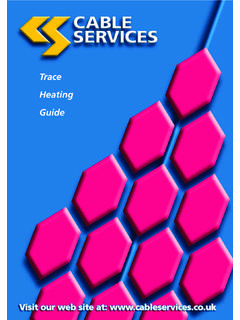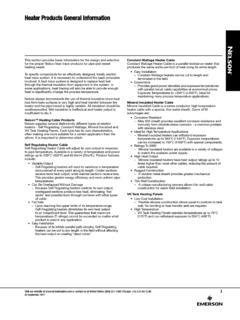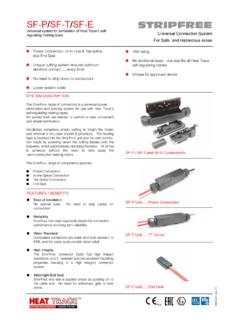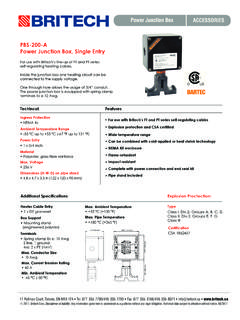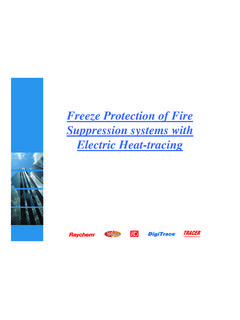Transcription of NELSON SPECIFICATION/APPLICATION SELF …
1 NELSON TYPE LT self - regulating HEATER cable SPECIFICATION/APPLICATION INFORMATION LT3-CB LT5-CB LT8-CB LT10-CB LT23-CB LT25-CB LT28-CB LT210-CB Optional Overjacket Standard Metal Braid Stranded Plated Copper Conductors self - regulating Conductive Bonded Inner Thermoplastic Jacket Outer Thermoplastic Elastomer Jacket Description: NELSON Type LT self - regulating heater cable is a parallel circuit electric heater strip. An irradiation cross-linked conductive polymer core material is extruded over the multi-stranded, tin-plated, 16-gauge copper bus wires. The conductive core material increases or decreases its heat output in response to temperature changes.
2 Two jackets provide extra dielectric strength, moisture resistance, and protection from impact and abrasion damage. The inner thermoplastic jacket is extruded over and bonded to the core material. A thermoplastic elastomer outer jacket is then extruded over the inner jacket. A stranded tinned copper metal braid is supplied on all heaters . An optional overjacket (fluoropolymer or modified polyolefin) can be specified when the heater cable is to be installed in wet or corrosive environments. Principle of Operation: The parallel bus wires apply voltage along the entire length of the heater cable . The conductive core provides an infinite number of parallel conductive paths permitting the cable to be cut to any length in the field with no dead or cold zones developing.
3 The heater cable derives its self - regulating characteristic from the inherent properties of the conductive core material. As the core material temperature increases, the number of conductive paths in the core material decrease, automatically decreasing the heat output. As the temperature decreases, the number of conductive paths increase, causing the heat output to increase. This occurs at every point along the length of the cable , adjusting the power output to the varying conditions along the pipe. The self - regulating effect allows the cable to be overlapped without creating hot spots or burnout. As the cable self -regulates its heat output, it provides for the efficient use of electric power, producing heat only when and where it is needed, and also limiting the maximum sheath temperature.
4 Application: NELSON 's Type LT self - regulating heater cable is ideal for use in maintaining fluid flow under low ambient conditions. Freeze protection and low watt density process temperature systems such as product pipelines, fire protection, process water, dust suppression systems, lube oil, condensate return, hot water and structure anti-icing are typical applications for this product. The base product is supplied with a tinned copper metal braid that may be used in both general applications and in dry, non-corrosive hazardous (classified) areas. It is also used to provide a conductive ground path when cable is installed on non-conductive surfaces, such as plastic or painted pipe.
5 Options: (Delete -CB and add) -JT A tinned copper metal braid with a modified polyolefin overjacket is available for use when the heater cable is exposed to aqueous solutions of inorganic chemicals (phosphate, dilute acids, chlorides, bases and carbonites). It is also recommended where mechanical abuse is a problem. -J A tinned copper metal braid with a fluoropolymer overjacket is available for use when the heater is available for use when the heater cable is exposed to excessive moisture, organic chemicals, solvents, etc. in hazardous (classified) areas and ordinary areas. D1- Approved for use in Class I, Division 1, Groups B, C, and D, Class II, Division 1, Groups E, F and G, Class III hazardous areas.
6 D1 heating cable requires the use of HASK series connection kits. NELSON TYPE LT SPECIFICATION/APPLICATION INFORMATION self - regulating HEATER cable Performance and Rating Data: Catalog Number Service Voltage Maximum Length Maximum Maintenance Temperature Maximum Intermittent Exposure T-Rating*LT3 120 325 150 F (65 C) 185 F (85 C) T6 LT23 240 650 150 F (65 C) 185 F (85 C) T6 LT5 120 270 150 F (65 C) 185 F (85 C) T6 LT25 240 540 150 F (65 C) 185 F (85 C) T6 LT8 120 210 150 F (65 C) 185 F (85 C) T5 LT28 240 420 150 F (65 C) 185 F (85 C) T5 LT10 120 180 150 F (65 C) 185 F (85 C) T5 LT210 240 360 150 F (65 C) 185 F (85 C) T5 *Electrical equipment T-rating codes define the maximum surface temperature that equipment will reach.
7 It is used in hazardous (classified) area applications . Circuit Breaker Selection: Max. Length (Feet) Vs. Circuit Breaker Size Start-Up 120 Volt 240 Volt Watts/Ft. Temp. 15A 20A 30A 40A 15A 20A 30A 40A 3 50 F (10 C) 325 650 0 F (-18 C) 230 305 325 460 620 650 -20 F (-29 C) 205 275 325 410 550 650 5 50 F (10 C) 225 270 460 540 0 F (-18 C) 155 205 270 310 415 540 -20 F (-29 C) 135 180 270 275 370 540 8 50 F (10 C) 145 195 210 295 390 420 0 F (-18 C) 100 130 195 210 200 265 395 420 -20 F (-29 C) 90 115 175 210 175 235 350 420 10 50 F (10 C) 115 150 180 230 305 360 0 F (-18 C) 85 110 155 180 165 220 325 360 -20 F (-29 C) 75 100 145 180 150 195 290 360 NOTES: 1.
8 Circuit breakers are sized per national electrical codes. 2. When using 240 volt product at 208, 220 or 277 volts, use the circuit adjustment factors shown in the Voltage Adjustment Table. 3. When using 2 or more heater cables of different wattage ratings in parallel on a single circuit breaker, use the 15A column amperage of 15 amps, divide it by the maximum footage to arrive at an amps/foot figure for each cable . You can then calculate circuit breaker sizes for these combination loads. These amps/foot factors include the 125% sizing factor. 4. National electrical codes require ground-fault equipment protection for each branch circuit supplying electric heating equipment.
9 Exceptions to this requirement can be found in the 2002 5. Heater cables with D1 optional construction require the use of ground fault interrupter/ground leakage device with a trip setting no greater than 30mA. NELSON TYPE LT self - regulating HEATER cable SPECIFICATION/APPLICATION INFORMATION Power Output Rating: (-1) (10) (21) (32) (43) (54) (65)TEMPERATURE DEGREES F(C) A LT3 B LT5 C LT8 D LT10 LT23 LT25LT28 LT210 WATTS PER FOOT x = WATTS PER METER PIPE TEMPERATURE F CONVERSION TO C = 5/9 ( F -32) NELSON TYPE LT self - regulating HEATER cable SPECIFICATION/APPLICATION INFORMATION Catalog Numbers: Standard Feature Suffix: BASIC CATALOG NUMBERS -CB Tinned Copper Braid Voltage Watts Per Foot Optional Features Suffix.
10 3 5 8 10 120 VAC LT3 LT5 LT8 LT10 -J Tinned Copper Braid and Fluoropolymer Overjacket 240 VAC LT23 LT25 LT28 LT210 -JT Tinned Copper Braid and Modified Polyolefin Overjacket D1- Division 1 approved Voltage Adjustment: Use of self - regulating heater products at other than rated voltages require minor adjustments in power and maximum circuit lengths. ADJUSTMENT MULTIPLIER 208 VAC 220 VAC 277 VAC Absolute Product Power Length Power Length Power Length Max Length LT23 .76 .93 .85 .96 650 ft. LT25 .79 .93 .87 .96 540 ft. LT28 .84 .93 .90 .96 420 ft. LT210 .86 .93 .92 .96 360 ft. Approvals: FM CSA UL Ordinary Locations - Ordinary Locations - Ordinary Locations - (-CB, -J or -JT options) (-CB, -J or -JT options) (-CB, -J or -JT options) Hazardous (Classified) Hazardous (Classified) Hazardous (Classified) Locations Locations Locations (-CB, -J or -JT options) (-CB, -J or -JT options) (-CB, -J or -JT options) Class I, Division 2; Class I, Division 2 Class I, Division 2.



